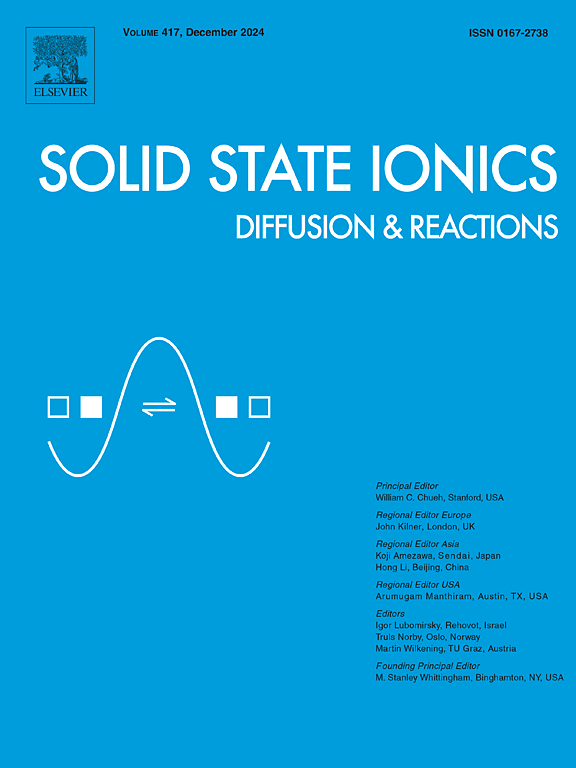Analysis of the electrochemical behavior of PANI synthesized galvanostatic method through electrochemical impedance spectroscopy
IF 3.3
4区 材料科学
Q3 CHEMISTRY, PHYSICAL
引用次数: 0
Abstract
Researchers across various fields have become interested in intrinsically conductive polymers (ICPs) due to their stability, ease of use, and conductivity. Polyaniline (PANI) is a prime example, with applications ranging from corrosion protection, electrochromic devices, and energy storage (electrodes). Despite its versatility, few studies explore its electrochemical behavior using the technique of electrochemical impedance spectroscopy (EIS). In this study, we synthesized PANI using a chronoamperometric technique (galvanic) at 0.70 V for 900 s. Cyclic voltammetry revealed the redox couple between leucoemeraldine and emeraldine states, along with the specific capacitance measured by galvanostatic charge-discharge (GCD). Electrochemical impedance spectroscopy analysis allowed observe the potential window and resistive and capacitive responses between 0.2 and 0.7 V through Nyquist plots. Interestingly, the low-frequency pseudocapacitive analysis showed high specific capacitance at 0.2 V (emeraldine phase) and for benzoquinone and hydroquinone (intermediate phases). Complex capacitance analysis corroborates that the most capacitive potential, corresponding to emeraldine, achieved actual capacitances (C′) of 151 mF.cm−2. Additionally, relaxation time constants were calculated, and the intersection points for complex power occurred at roughly 70 % for the most capacitive potentials. These results identify the potentials with capacitive and resistive characteristics, providing a deeper understanding of PANI's properties, which can help in future studies using polyaniline in electrochemical applications.
利用电化学阻抗谱分析恒流法合成聚苯胺的电化学行为
由于其稳定性、易用性和导电性,各个领域的研究人员对内在导电聚合物(icp)产生了兴趣。聚苯胺(PANI)就是一个典型的例子,其应用范围包括防腐蚀、电致变色器件和储能(电极)。尽管其用途广泛,但利用电化学阻抗谱(EIS)技术研究其电化学行为的研究很少。在这项研究中,我们使用计时电流技术(电流)在0.70 V下900 s合成了聚苯胺。循环伏安法揭示了绿绿宝石和绿绿宝石之间的氧化还原偶联,并通过恒流充放电(GCD)测量了比电容。电化学阻抗谱分析可以通过Nyquist图观察0.2 ~ 0.7 V之间的电位窗口和电阻和电容响应。有趣的是,低频伪电容分析显示,在0.2 V(翡翠相)和对苯醌和对苯二酚(中间相)具有较高的比电容。复电容分析证实,与翡翠相对应的大部分电容电位的实际电容(C′)为151 mF.cm−2。此外,计算了松弛时间常数,发现大多数电容电位的复功率交点约为70%。这些结果确定了具有电容和电阻特性的电位,为进一步了解聚苯胺的性质提供了依据,有助于进一步研究聚苯胺在电化学中的应用。
本文章由计算机程序翻译,如有差异,请以英文原文为准。
求助全文
约1分钟内获得全文
求助全文
来源期刊

Solid State Ionics
物理-物理:凝聚态物理
CiteScore
6.10
自引率
3.10%
发文量
152
审稿时长
58 days
期刊介绍:
This interdisciplinary journal is devoted to the physics, chemistry and materials science of diffusion, mass transport, and reactivity of solids. The major part of each issue is devoted to articles on:
(i) physics and chemistry of defects in solids;
(ii) reactions in and on solids, e.g. intercalation, corrosion, oxidation, sintering;
(iii) ion transport measurements, mechanisms and theory;
(iv) solid state electrochemistry;
(v) ionically-electronically mixed conducting solids.
Related technological applications are also included, provided their characteristics are interpreted in terms of the basic solid state properties.
Review papers and relevant symposium proceedings are welcome.
 求助内容:
求助内容: 应助结果提醒方式:
应助结果提醒方式:


